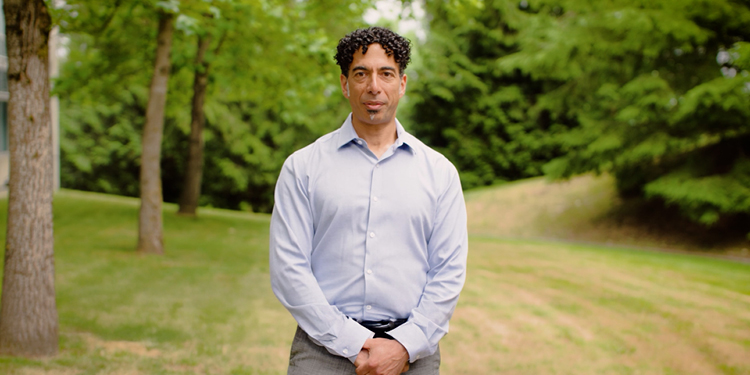How a successful pilot project became a rewards program for customers
April 8, 2024
When you come home from work, you turn the heat (or AC) up, plug in your phone, turn on the TV and start cooking. The problem is, so does everyone else. This peak electricity usage between 4 and 9 p.m. just keeps increasing along with our population, and the number of devices we plug in. But what if there was a coordinated way to reduce peak energy use?
Enter FortisBC’s innovative technologies team
Sounds like an ideal job for our innovative technologies team, who create pilot programs to test technology that’s designed to lower energy consumption. Much of this team’s work helps our customers lower their overall emissions, supports the province’s climate action goals by 2030 and our long-term vision to 2050. We offer financial incentives and special rebates to recruit customers to test technology in real-world conditions, in their homes and businesses.
In this case, the team wanted to test whether customers with Wi-Fi-connected devices like thermostats would allow FortisBC to control their devices remotely via innovative technology. The ultimate goal was to lower energy use during peak hours of the day while keeping customers comfortable.
How did the Peak Saver pilot program work?
The Peak Saver pilot program provided financial rewards to residential electricity customers who lowered their energy usage during peak demand periods, like the hottest and coldest days of the year. "By signing up and participating in the program, customers could earn financial incentives and reduce peak demand on the electricity system," explains Max Mathies, FortisBC peak and capacity mitigation manager.
For example, when a heat wave hits, we know everyone is going to crank the AC at the same time. During the pilot, when an extra hot day was on the horizon, participants would be asked in advance if they’d be willing to have their thermostat adjusted for two to four hours.
“They always have the option to say no,” Max says. “But most participants agreed to allow this, and we’d start by increasing their air conditioning first to really cool down their home before turning it off altogether for a couple of hours. Then we’d slowly turn the AC back on and gradually get it back to where the customer initially set it… We wanted to see if we could effectively reduce peak electricity demand without inconveniencing our customers."
Another aspect of the program was reducing electric vehicle charging during peak hours. Participants were given financial incentives to charge their vehicles before 4 p.m. and after 9 p.m.
The path to success
The decision to launch the Peak Saver pilot program was informed by the success of similar programs at other utilities. From there, it was about finding the right software vendor to partner with and getting customers to sign up. Collaboration with connected thermostat manufacturers was key in recruiting participants, as they promoted the program to their customers.
The Kelowna area was identified as potentially needing increased electrical system capacity, so the pilot targeted customers in that area with Wi-Fi connected electrical devices (such as thermostats controlling electric space heating and air conditioning, electric vehicle chargers, hot water tanks and pool pumps).
The pilot's success hinged on customer willingness to participate and not feel like they were inconvenienced or uncomfortable. "The vast majority of our participants didn’t really notice any impact on their lives throughout the pilot, and most appreciated the notice we gave them for Peak Saver events," says Max.
The success of pilot programs is always exciting because it means that we’re making strides towards smarter use of energy.
Max Mathies, program manager, peak and capacity mitigation
Transitioning to a permanent program
The decision to create a permanent program with this technology was data-driven. "Based on positive feedback from our customers who participated, and a third-party evaluation of the pilot, FortisBC decided to make this an ongoing program," Max says. Just like the pilot, participants are offered a sign-up incentive and ongoing financial rewards for participation.
Now called the Power Hours Rewards Program, it’s available to customers across our electricity service area, excluding a few areas with municipal electrical utilities (Summerland, Penticton, Grand Forks and Nelson). It’s specifically focused on thermostat adjustment during peak hours and avoiding charging electric vehicles during peak hours, as those were the initiatives where we saw the highest levels of participation during the pilot program.
Pilot program participants are helping create the future of energy use and efficiency
Max is optimistic about the path forward with the level of engagement he’s seen with pilot programs like Peak Saver. He emphasizes the importance of community involvement in addressing the challenges of energy consumption.
“It’s promising that we have so many customers who are willing to participate in these pilots to help us understand the ways we can work together, as this really isn’t a problem that can easily be solved by FortisBC alone. It makes me hopeful that even though we’re coming up against serious challenges, our customers are understanding and we can find ways to work with them on programs like this one.”
We need you!
If you want to test new technology and earn rewards for saving energy, sign up to get information on upcoming pilot programs!



